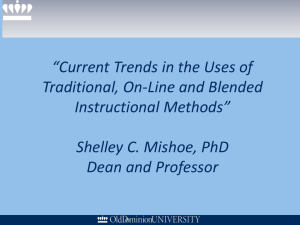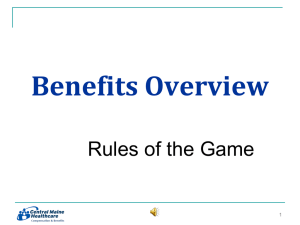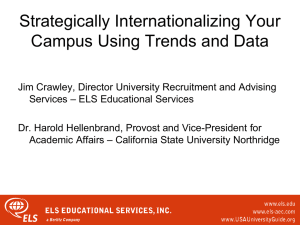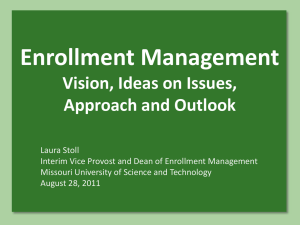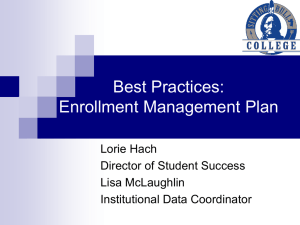Precision Scheduling I PowerPoint Presentation
advertisement
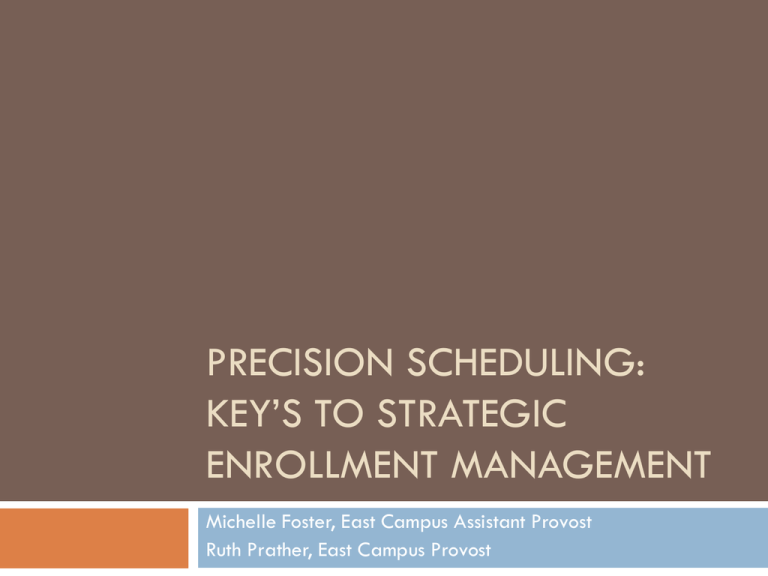
PRECISION SCHEDULING:
KEY’S TO STRATEGIC
ENROLLMENT MANAGEMENT
Michelle Foster, East Campus Assistant Provost
Ruth Prather, East Campus Provost
Agenda
Fast Facts
Challenges
Our roles as Campus Leaders
Developing Good Principles
Facilities
Schedules
Faculty
Defining Enrollment Management
Data Review
Strategic Enrollment Planning Process
Managing the Demand
Fast Facts……..
The U.S. Department of Education Institute of Education Services
National Center For Education Statistics
Enrollment increased 26% [14.5 million to 18.2 million]
between 1997 and 2007.
Full Time – 34%
Part-Time – 15%
The number of young students has grown more rapidly
than the number of older students; but this pattern is
expected to shift.
Projection: from 2006 to 2017 NCES predicts a rise of
10 percent in enrollments of people under 25 and a
rise of 19 percent of people 25 and older.
Valencia Fast Facts………..
* Valencia Statistical History Fact Book 2008-2009
Population Projections*
2015
2025
Florida
7.5 to 24.1%
12.5 to 33.9%
Orange
-1.7 to 20.1%
3.1 to 54.7%
Osceola
5.9 to 34.8%
20.3 to 96.3%
Enrollment Growth Over last 3 years exceeded 36%
Enrollment growth exceeds Enrollment planning
Plan for 5 to 6 % growth
Actual Enrollment 10 -12%
Challenges
Increase in demand
Declining state and
federal budgets
Changes in workforce
Competitive
Educational
Environment
Changing Student
Demographics
Recruiting & Retaining
Faculty
Rising Costs to provide
academic and student
support services
Limited Facilities
Resources
Unemployment
Fewer Financial Aid
Resources for Students
Roles and Responsibilities {Provost &
Assistant Provost}
Develop good principles
[Communication/Collaboration/Coordination]
Facilitate:
Strategic Planning & Goal Setting
Faculty Hiring
Class Schedule Building
Space Utilization
Technology in support of learning
Empower Deans & Faculty Chairs
Ensure Excellence [Plan, Execute, and Assess]
East Campus Core Principles for Enrollment
Supports an optimum learning environment based on
standards of excellence
Supports effective resource allocation
Contributes to campus and college enrollment goals
Provides for appropriate faculty and student support
systems in all delivery and scheduling options
Reflects College and Community needs
Ensures shared decision making process with effective
engagement of primary stakeholders
Provides for “best-proactive” approach to student- and
learning-centered service
Align with College Strategic Plan
Current Valencia Enrollment Goals
Facilitate Enrollment Growth – 8% Fall 2010
Support Learning Assured and Start Right Principles
Build Class Schedule based on student demand
Increase online offerings that align with Alternative Delivery Standards Plan
Increase Flex Term offerings that align with College-on-Demand Report
Support uniform class scheduling policies/procedures
Increase Space Utilization
Support Recruitment & Retention of Faculty
Distribution of Classes is scheduled to maximize resources
Faculty
Facilities
Technology
Respond to Demographics and Economic Changes
Evaluate Strategic Enrollment & Facilities Process Continually
DEFINITION: Enrollment Management
Enrollment Management is an institution-wide,
systematic, comprehensive, research-driven system
designed to locate, attract, retain, and graduate the
students the institution wishes to serve.
From: Noel-Levitz: “Enrollment Strategies That Work in Attracting and Retaining Students”
Enrollment Management is:
An organized and systematic approach to managing
resources:
Faculty
Space
A philosophy reflected in activities that have the
support of administration, faculty, and staff.
Start
Right
Learning Assured [Learning Centered]
Where to start……
Begin with the end in mind….. S. Covey
“Who” are the students we ultimately want?
“Where” are they?
“What” is it that they expect/desire?
“When” do they want it?
“How” do they want it delivered?
“Why” do they want it?
NOTE:
Answers to these questions will help determine the information
we need to track and evaluate.
Data Review
Demographic Information
High School Graduation
Projections
Satisfaction Surveys
Recruitment/Enrollment Trends
Student Assessment of Instruction
Retention/Student Success Rates
Withdrawal Rates
Grade Distributions
Community College Survey of
Student Engagement [CCSSE]
“Functional Evaluations”
[i.e.
divisional surveys, professional
organization surveys]
“Best Practice” Review
Zip Code Enrollment Distributions
Economic Trend Data
Consultants
Space Utilization Reports
Site Visits
Conferences
Instructional Reports [Full- and
Part-Time Faculty
Student Characteristics Report
Two KEY reports in Enrollment
Management
Red/Green
Daily Report on Course
Enrollments
Run during Open Registration
Allows Pro-Active Enrollment
Management by Deans
Provides Provost with Snapshot
of Enrollment
Section/Capacity/%Filled
Weekly/Monthly Report on
Capacities and Sections
“Section Management”
Run in weeks prior to open
Registration and at end of
term [for comparison]
Provides Provost with a
snapshot of how efficiently
courses/faculty were
scheduled.
Red/Green Report
Color Key:
Red – 10 or less enrolled
Lt Green – 5 or less seats open
Dk Green – Reserve
Lt Blue – Cancelled
Dk Blue – Online
Yellow – Selected Topics/Intern
Orange – Cap set at 0
Report Key:
POT = Part of Term
Mode = Delivery Method
Actual = # Enrolled
Open = Open seats
Cap = Capacity
Instructional Report on Sections, Capacity, and
Enrollment
Sections: Have we
built capacity
correctly?
Enrolled in Previous
“like” Term: Did our
enrollment
meet/exceed our
capacity?
% Filled: How well
efficiently did we
schedule our
sections?
Distribution by TIME/MODE
Divisional Report on “Top Enrollment
Courses”
[Prescriptive Enrollment Modeling]
Enrollment Management is:
A comprehensive institutional process that extends
beyond recruitment and admissions functions.
A complex and holistic approach to analyzing and
influencing enrollment from inquiry to graduation.
A campus-wide process that integrates often
disparate functions and personnel, including
recruitment, financial aid, institutional research,
teaching/learning, and student services
From: Noel-Levitz: “Enrollment Strategies That Work in Attracting and Retaining Students”
Strategic Enrollment Management
People
+
President
Vice President
Provost Team
Deans
Directors
Discipline Chairs
Administrative Assistants
Students
Technology
Reporting/Data
Tracking Systems
Enhanced Academic
Support Systems
Online Student Support
Services
Online Learning
Electronic Systems
Enrollment Planning Model
Enrollment & Facilities System Overview
Laying the foundation……
Aligned with principles and College
Policies/Procedures
Scheduling
Facilities – Banner
Campus Room Scheduling/Event Scheduling Procedures
Developed
Aligned with Fire Code Standards
Aligned with Facilities – State Reporting Standards
Inventoried all “spaces” on Campus
Class Schedule “Building Calendar”
TERM
Class Schedule to:
Deans
Class Schedule to:
Provost
Class Schedule to:
Web
Fall
November 15
March 1
March 15
Spring
February 1
May 1
May 15
Summer
July 1
October 1
October 15
Dean Scheduling Jurisdiction Ends
The Foundation………………
Enrollment
Facilities
Class Schedule
Building
Timeline
[Fall, Spring,
and Summer] &
Scheduling Jurisdiction
Faculty Hiring
Full-
and Part-Time
Room Scheduling
Lab Scheduling
Event Scheduling
Student
Development
Activities
Meetings
The building blocks
Enrollment
Curriculum Cap
Facility
Course
and Discipline
based; determined by
faculty
Enrollment Count
Live
and rolling
number
Facility Cap
Maximum allowable
seats in a room/lab
Fire Code
State Guidelines
Section Cap
Maximum number of
students that can enroll in
a section
Enrollment & Facilities System Review
Data Model / Data Dictionary
Measures (Occupancy, Utilization, Facility Availability, Seat-Hours, …)
Dimensions (Facility, Calendar, Clock, Timeline)
Sample Room Schedule tools
Graphical Reports: (Day of Week Report)
Text Based Reports: (Room Schedules)
Sample Reports
Room to Campus to College Level Reporting
Uses:
Security
Food Service
Tutoring
Facility Planners
Student Development
Instructional Technology/AV
WHY Enrollment Management?
Proactive management of resources
Faculty
Facilities
Student – Centered
Quality Management
Enhances recruitment, retention, and graduation
planning
Creates a continuous “Best Practice” of assessment,
planning, and execution
Valencia Resources:
Supporting Documentation
http://www.valenciacc.edu/provost/east/teamPresenta
tions.cfm
Institutional Research Home
http://www.valenciacc.edu/ir/
Valencia Strategic Plan
http://www.valenciacc.edu/lci/
Precision Scheduling
Question
&
Answer
